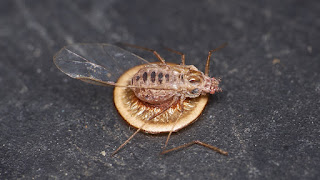The phone rang as I was just leaving Wellington.
My passenger answered it.
"We are stuck in a traffic jam and will be 30 minutes late." we were told.
Thanking them for the information the call ended.
It was only a few minutes later that I realised we were heading in the same direction and would end up getting stuck in the same traffic jam!
And we did!
Roadworks just outside Dorrington.
Actually they were path-works as the work force were clearing vegetation that had grown over the existing path in order to reclaim the full width of the path. It needed to be done; but to do it safely they had to close one of the lanes and use traffic lights which caused a log jam on this busy road.
We got to the car park in All Stretton about 10 minutes late.
Six of us met in the bottom car park before making our way up to the second car park where we were joined by members of the Shropshire Wild Team.
The Shropshire Wild Team consists of volunteers who are involved in landscape management projects as well as other outdoor activities. A little while ago members of the team attended a "Learn to Love Spiders" course and had come along for the day to reinforce this training.
Our spiderman was in his element as he was able to talk about spiders all day long to a really attentive and appreciative audience!!
There was a large patch of thistles by the second car park.
This patch attracted a lot of butterflies including Gatekeepers.
And this fly with an extremely long proboscis which can be seen probing the thistle in the following photograph. It is a tachinind fly - Prosena siberita.
 |
| Photograph: Bob Kemp |
The process of catching up began. Unfortunately it is difficult to just catch up. Things of interest that "must" be investigated get in the way. If anything along with a couple of other stragglers I was getting further behind.
In the end a determined effort was required to rein in the others. It helped that they had come to a split in the path and were wondering which one to take. I solved the problem by declaring lunch-time. This decision was greeted favourably and we settled in the shade of a tree by the stream.
A Golden-ringed dragonfly was photographed as it rested on the vegetation at the side of the stream.
 |
| Photograph: David Williams |
 |
| Photograph: Bob Kemp |
 |
| Photograph: Bob Kemp |
As with most areas at the moment it was showing the effects of the lack of rain for an extended period.
Just to the left of the photograph a pool had been excavated. It was dry but the vegetation around it was lush and green!!
We spent quite a bit of time searching in this area before the heat of the day began to make itself irresistible.
Although it was still quite early we all decided that we were happy to return to the cars and go home.
So we did.
On the way we found a very hairy caterpillar; the larva of the White ermine moth.
 |
| Photograph: David Williams |













































































